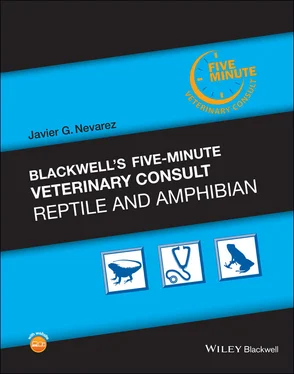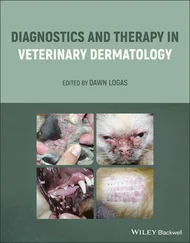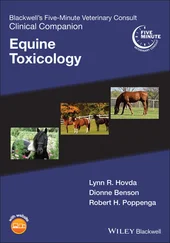Supportive treatment should always include appropriate analgesia, as in other species this is known to be a painful condition.
Euthanasia may be considered in severe cases.
Some patients may be anorexic and severely dehydrated on presentation.
Fluid deficits should always be corrected, and nutritional support provided.
Care should be taken to provide an appropriate diet low in dietary purines to minimize further uric acid production.
CLIENT EDUCATION/HUSBANDRY RECOMMENDATIONS
Husbandry should be reviewed to identify any predisposing factors, such as inappropriate temperatures or low humidity, and these should be corrected.
Clean fresh water should always be available in a recognizable form for the species.
Diet should be reviewed to ensure that it is appropriate for the species and not too high in protein.
Clients should be advised that this is a condition that will require long‐term management and can potentially be very painful if allowed to progress.
Surgical removal of tophi may be considered if only one joint is affected, but permanent damage to the joint may already have occurred.
 MEDICATIONS
MEDICATIONS
DRUG(S) OF CHOICE
Allopurinol is the most common choice for treating gout. It is a xanthine oxidase‐inhibiting drug that works by inhibiting the conversion of hypoxanthine and xanthine to uric acid in the liver, consequently reducing blood uric acid levels.
If blood uric acid levels remain consistently low, existing deposits may potentially dissolve.
Doses of 10–20 mg/kg PO q24h are recommended for most species.
Long‐term medication will be necessary to prevent relapses.
Other drugs to promote uric acid excretion such as probenecid can theoretically be used but are contraindicated in dehydrated patients.
In cases of visceral gout, allopurinol should also be avoided as it increases uric acid excretion by the kidneys and could theoretically make the condition worse.
Allopurinol and probenecid may potentially interact, although the clinical significance of this interaction in reptiles is unknown.
 FOLLOW‐UP
FOLLOW‐UP
PATIENT MONITORING
Response to therapy is usually monitored by physical examination findings (e.g., increase in activity levels or no progression in joint swellings).
Repeat blood samples can also be taken to recheck uric acid levels which would be expected to start reducing within 7 days of allopurinol treatment.
EXPECTED COURSE AND PROGNOSIS
The prognosis for patients with severe widespread disease is poor, but if diagnosed early the condition could be managed successfully.
If left untreated, the disease will progress with widespread uric acid deposition ultimately resulting in organ failure and death.
 MISCELLANEOUS
MISCELLANEOUS
COMMENTS
N/A
N/A
N/A
Veterinary Information Network: www.vin.com
1 Casimire‐Etzioni AL, Wellehan JF, Embury JE et al. Synovial fluid from an African spur‐thighed tortoise (Geochelone sulcata). Vet Clin Path 2004;33(1):43–46.
2 Dallwig R. Allopurinol. J Exot Pet Med 2010;19(3):255–257.
3 Mader DR. Gout. In: Mader DR, ed. Reptile Medicine and Surgery. 2nd ed. St. Louis, MO: Elsevier Saunders; 2006:374–379.
AuthorJoanna Hedley, BVM&S, DZooMed (Reptilian), DECZM (Herpetology), MRCVS
Hepatic Lipidosis
 BASICS
BASICS
DEFINITION/OVERVIEW
Hepatic lipidosis is the excessive accumulation of triglycerides in the hepatocytes and can result in altered hepatic function. It is expected to be a reversible lesion if the underlying cause is corrected. It is a common lesion diagnosed in reptiles.
Triglyceride accumulation in hepatocytes can occur due to disturbances of lipid metabolism from primary metabolic liver disease, toxins, protein malnutrition, diabetes mellitus, obesity, anorexia (increased fatty acid mobilization from peripheral stores), extrahepatic visceral inflammation, and anoxia (inhibits fatty acid oxidation).
In female reptiles, the change can be associated with folliculogenesis.
The common factor for each of these possible etiologies is a negative balance between the rates of deposition and dispersal of fat from the liver, resulting in an accumulation of triglycerides in the liver.
In reptiles, obesity from rich diets can result in hepatic lipidosis and enlargement of the coelomic fat bodies.
Reduced activity will also contribute to increased fat deposits and is not uncommonly reported condition in monitors and turtles.
In tortoises, a lack of normal hibernation and reproductive activity can lead to hepatic lipidosis.
Hepatic lipidosis is reported to be more common in turtles. Data from one laboratory (D Reavill, unpublished) found the percentages of hepatic lipidosis in the reptile groups with the liver submitted for evaluation, as follows:chelonians (turtles and tortoises) (97/676) 14%lizards (304/1485) 20%snakes (91/1672) 5.4%
There is a reported difference in tolerance to the condition, with turtles being more resistant to metabolic derangements.
The clinical signs are generally non‐specific.
Signs include weakness, depression, pale oral mucous membranes, and non‐specific neurologic signs.
Green to blue urates are reported, and clay‐like, tan, or watery feces may also be noted.
Inappropriate diet and overfeeding, such as chelonians fed only canned dog food.
Chronic stress: inappropriate captive husbandry conditions (POTZ, cage size, feeding strategies).
Inactivity: restricted physical activity due to space or adequate stimulation.
Inappropriate support for reproduction
Inappropriate hibernation conditions
Anorexia/hyporexia: desert and sulcata tortoises that have failed to eat for more than 1 week.
N/A
 DIAGNOSIS
DIAGNOSIS
Although the presumptive diagnosis is based on history, clinical signs, laboratory data, and imaging, the definitive diagnosis is made by microscopic evaluation of a liver biopsy or necropsy examination.
Читать дальше

 MEDICATIONS
MEDICATIONS FOLLOW‐UP
FOLLOW‐UP MISCELLANEOUS
MISCELLANEOUS BASICS
BASICS DIAGNOSIS
DIAGNOSIS










